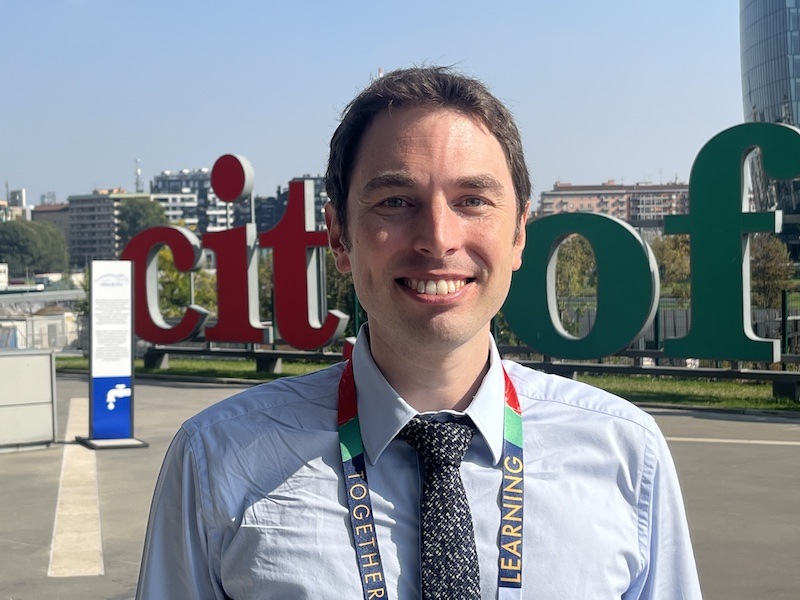
The developers of a cannula for minimally-invasive central aortic perfusion—MIC-Cannula—received the European Association for Cardio-Thoracic Surgery (EACTS) Techno-College Innovation Award 2022.
The award, which is chosen by the EACTS New Technology Committee, was presented during the society’s annual meeting (5–8 October, Milan, Italy). Francesco Pollari (Klinikum Nürnberg, Paracelsus Medical University, Nuremberg, Germany) who developed the device alongside his colleague and wife Michela Cuomo, a paediatric cardiac surgeon, speaks to Cardiovascular News about the device and its potential applications.
Where did the idea for the device originate?
The idea originated from our experience in minimally invasive cardiac surgery and also from my personal experience in transcatheter aortic valve implantation (TAVI). Typically, these two areas are separate. There are surgeons who exclusively perform minimally invasive surgery and others who may exclusively perform TAVI. In our career we had the opportunity to perform both, and for this reason I developed the experience in using a wire and to use catheter techniques.
That is why I felt minimally invasive perfusion has some limitations, but also that we could improve those using some techniques that are routinely used in TAVI, for example, the use of a longer wire, and a long introducer that are usually used for advancing the prosthesis in TAVI. I thought that could be the perfect solution to improve perfusion in a minimally invasive setting.
How easy was it to conceptualise the design of the device?
The main problem was to understand if it was only a fantasy! The concept is creating something new. We were worried we were wasting our time or our energy in something that could not become reality. I had the strength in confronting this problem together with my wife. At least two surgeons were agreed that it could work, and that encouraged us to write the project and to apply for an international patent. Finally, after three years it was granted from the European Patent Office (EPO) and that was in the same week we received the award from the Techno-College. For a long time, we were not sure it could be a good idea, but finally we have obtained our recognition.
How does the device work?
The device allows antegrade perfusion in a minimally invasive setting. That is the novelty of this device and that was the limitation of the prior state of the art. The present minimally invasive cannulas are not able to perform antegrade perfusion, only retrograde perfusion. This new device overcomes this problem. It is inserted through the femoral artery, and it is long enough to reach the aortic arch where the oxygenated blood is perfused in the distal part of the cannula. The whole cannula has a thin diameter and that allows removal without the need for surgery or without using a standard vascular closure device.
That is very important because many cardiologists will not always have a cardiac surgeon on site. If cardiology has a complication during an elective or an emergency percutaneous coronary intervention (PCI), the only solution they have is to place a peripheric perfusion system. With this cannula they could perform a better perfusion, without a cardiac surgeon.
There are also applications in cardiac surgery. As a cardiac surgeon myself I designed this so that it could be used in every minimally invasive elective cardiac surgery.
It could also be used in intensive care medicine especially for severe respiratory distress independent from cardiogenic shock. In severe respiratory distress through this new device, it can help to avoid upper body hypoxaemia, known as Harlequin Syndrome.
The cannula is also equipped with radiopaque markers and has other characteristics such as the curved shape of the distal part to respect the anatomy of the aortic arch.
What study has been carried out to date to validate the concept of the device?
There has been an independent study by a group in Aachen who have performed a computer fluid dynamic analysis. They were aware of the problem of Harlequin Syndrome and they performed the study simulating how to address this problem. That was lucky for us, because they proved with a computer fluid analysis that a cannula with our characteristics could be the optimal solution to overcome this problem.
That was an independent study that adds value to our idea, but we will go further with our own studies.
What will receipt of the Techno-College innovation award mean for your development of the MIC-Cannula?
The award and the participation at the EACTS annual meeting allow us to get in contact with partners that could help us in developing this idea. To further develop the idea, we will not only need funding but also knowhow. Our knowhow is limited to our area of competence, cardiac surgery, but from bringing the idea from patent to reality there is a long road and the cooperation with partners is indispensable. The award from the Techno-College and the participation at the meeting is the best opportunity to find the right cooperation.
What is your advice to other surgeons bringing through new innovations?
Brainstorm, speak and think together. I had the luck to have this opportunity in my home because I married my colleague! But I am strongly a believer that the best idea comes from confrontation. Medicine consists of complex problems in every area, it would be very arrogant to think that one doctor could cure a patient alone. Cooperation in medicine is the key, and to develop new ideas it is the same. Through speaking and brainstorming an idea can be born and grow further.










